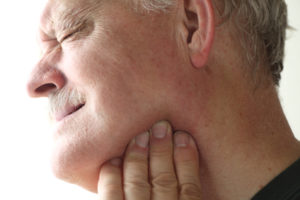 TMJ, or the temporomandibular joint, is the name given to the two joints of either side of the face that hinge the jaw bone, or the mandible, to the skull. The TMJ allows movement of the jawbone side to side, limitedly, and up and down, which is how we chew our food, talk and yawn. This joint moves effortlessly, because it is lined with cartilage, and has a larger range of motility from the other joints in the body. The problem arises when the TMJ becomes a source of pain, because of causes like infections, injuries to the jaw bone or the joint, prolonged stretching or opening, as in insertion of an ET tube during surgeries, forceful yawning, a visit to the dentist, fractures or dislocations of the joint, as well as sometimes because of severe osteoarthritis.
TMJ, or the temporomandibular joint, is the name given to the two joints of either side of the face that hinge the jaw bone, or the mandible, to the skull. The TMJ allows movement of the jawbone side to side, limitedly, and up and down, which is how we chew our food, talk and yawn. This joint moves effortlessly, because it is lined with cartilage, and has a larger range of motility from the other joints in the body. The problem arises when the TMJ becomes a source of pain, because of causes like infections, injuries to the jaw bone or the joint, prolonged stretching or opening, as in insertion of an ET tube during surgeries, forceful yawning, a visit to the dentist, fractures or dislocations of the joint, as well as sometimes because of severe osteoarthritis.
TMJ problems can turn into a very big setback, as basic functions like talking and chewing become painful, restricted, and this soreness spreads along the neck, sometimes down to the shoulders as well. Treatment modalities for TMJ are varied, depending on the cause, but recently the use of BOTOX has come into focus. BOTOX has been established as a very effective method of reducing the pain associated with TMJ. Its relieving effect extends to pain that is caused by progressive strain in muscles around the TMJ, like pain caused by cervical dystonia, and TMJ related chronic headaches. The mechanism behind this is that BOTOX causes muscle paralysis, but not completely, only to a partial extent. When these muscles are paralysed, they relax from their state of contracture, and this relieves the direction of forces that act normally on the TMJ, that is, these muscles become relaxed, and cannot exert push or pull on the TMJ. This prevents unnecessary movement of the joint, which is responsible for the pain that patients feel.
The effect of BOTOX in treatment of TMJ is pain relief. While the pain is managed, better focus can be placed on isolating and treating the cause of the TMJ discomfort, without the patient’s daily life being affected as much. The advantage is that BOTOX can be given very quickly. The treatment does not require hospitalization, before or after the injections. Simply injections given by a good, licensed medical practitioner will suffice, to stall the effect of pain on the patient’s quality of life. And the onset of relief is very rapid. In a day or two, patients notice that the pain has begun to subside, as the muscles relax, and the effect is complete within the first week. Unlike systemic analgesics, there are no side effects, no withdrawal symptoms or addiction potential from chronic pain management medication, no drowsiness, etc. It’s a simple, localized effect that does not spread beyond the immediate site of the injection, provided that the patient does not massage the site of injection vigorously or rub it again and again. And it is relatively painless too. The number of injections needed differ from patient to patient, depending upon the severity and site of pain. And other than mild bruising in some patients, no noticeable effects occur to the skin, either. If you are suffering from TMJ related pain, then consider looking into BOTOX for treating TMJ.









